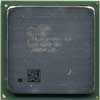Intel Celeron 1.7GHz - Pentium 4 Powered
by Anand Lal Shimpi on May 16, 2002 4:04 AM EST- Posted in
- CPUs
Half a Willamette
The new Celeron core is based on a 128KB L2 version of the original Willamette core that the Pentium 4 debuted with in November of 2000. Unlike previous-generation Celerons, the Willamette-128 core is no different architecturally than the Pentium 4's old Willamette core. The cache organization and mapping algorithms are still the same, the only difference is that the Celeron core is only outfitted with a 128KB L2 cache instead of the 256KB cache present on the original Pentium 4.
Only having a 128KB L2 cache increases the Celeron's dependency on a high-speed memory bus. Luckily, the processor will work just fine on an 845 or 850 platform both of which offer a significantly larger amount of memory bandwidth than the i815 that the older Celerons were often paired with. With only a 128KB L2 cache, the new Celeron would appreciate the higher bandwidth i850 even more than the Pentium 4. Keep in mind that the short-lived Tualatin based Celeron processors had a 256KB L2 cache; there are situations where the new core can be outperformed by its predecessor.
Keep in mind that the first generation Pentium 4s didn't always fare so well against the Pentium III and especially the Tualatin based processors. Now with a smaller L2 cache, it will take even more for the Celeron to do well. For information on the NetBurst architecture behind the Celeron take a look at our one page explanation of its strengths and weaknesses.
The new Celeron also uses the now "old" 100MHz quad-pumped FSB, delivering a total of 3.2GB/s of FSB bandwidth. This won't be a limitation for quite a while as the Celeron won't be ramping up to clock speeds nearly as high or nearly as quickly as with the Pentium 4. The quad-pumped FSB fixes an age-old problem with the Celeron - a lack of FSB bandwidth, and when paired with DDR memory on an i845 or even RDRAM on an i850 the issue of low main memory bandwidth is nonexistent as well.
The introductory speed of the new processor is 1.7GHz running at 1.75V. Remembering that this is a 0.18-micron core helps explain the reason behind the high core voltage. Speaking of which, the new Celeron is only being introduced on the 0.18-micron process but will undoubtedly migrate down to 0.13-micron as quickly as possible. Intel still has a good amount of 0.18-micron manufacturing capacity and until those fabs get converted over for 0.13-micron production we won't see a significant push for a smaller Celeron (the 128KB L2 cache already makes it very cheap to produce).
Although the use of Intel's 0.18-micron severely limits the overclocking potential of the chip, remember that Intel got the Pentium 4 up to 2GHz on this process and that was with twice as much cache and significantly more transistors.
It's safe to assume that after the Celeron hits 2GHz Intel will transition it to a derivative of the Northwood core, most likely with a 256KB L2 cache. But until that time we have to deal with the warm-running 0.18-micron Celeron at 1.7GHz.












0 Comments
View All Comments